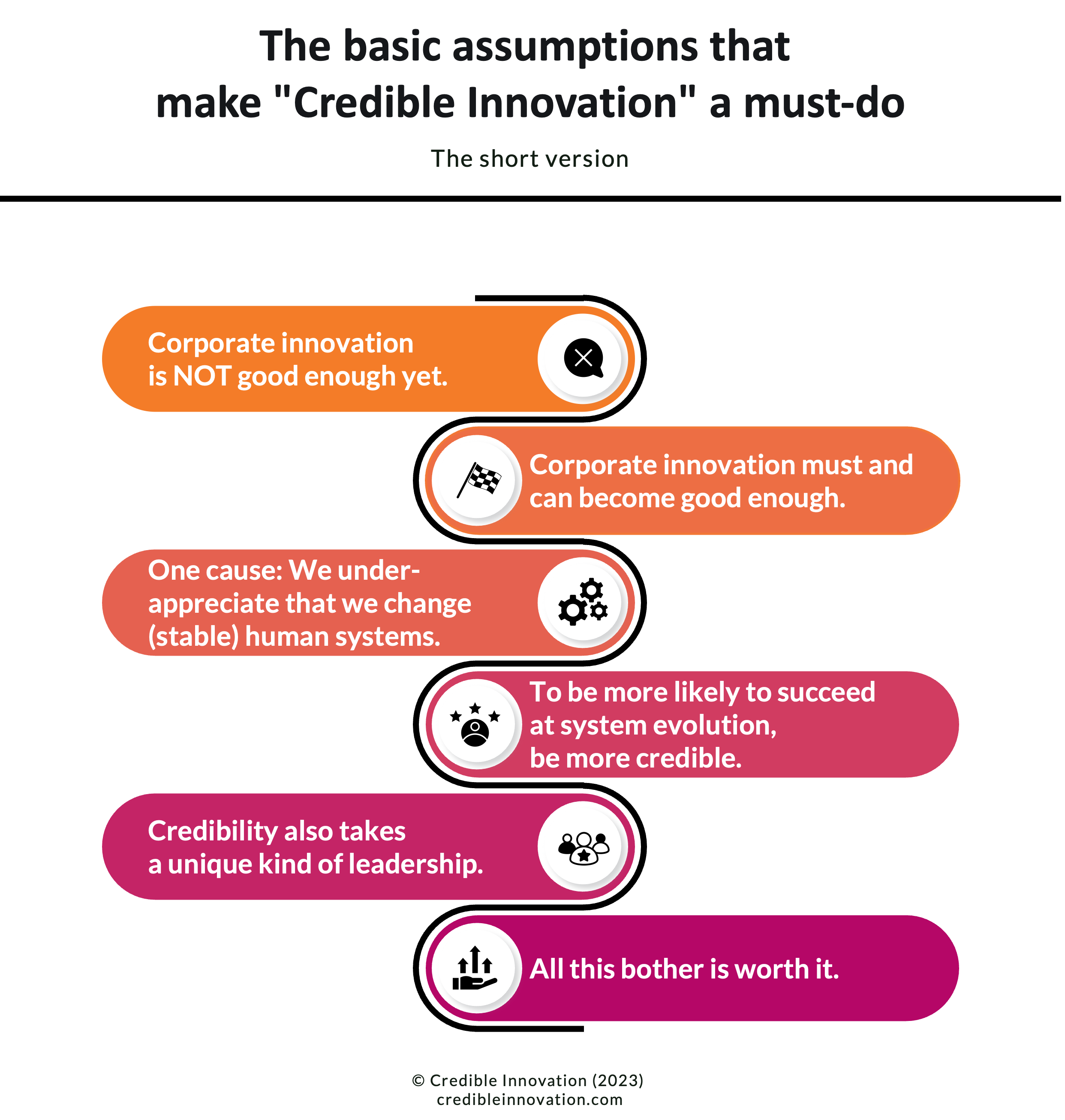TL; DR
So far, I have found six critical assumptions on which this "Credible Innovation" idea appears to stand.
Buy into them, and the rest will follow, as far as I can tell. (Until I learn better. It's a sacrificial draft and will very likely evolve.)
Reasonable people may disagree with these assumptions. Test them. But if these axioms and their initial implications feel sound to you, then the work of this site really matters.
The assumptions fundamentally amount to this argument:
The world needs corporate innovators. But our discipline doesn’t do a good job yet. We have not figured it out. (At least) some of the issues require basic mindset changes to solve them. Accept those new perspectives, and several important problems of our craft appear easier to untangle.
The six axioms on which "Credible Innovation" stands
Challenge axioms
Solution axioms
Explanations and practical implications of these axioms (aka, why these things matter)
Nobody in their right would cut Finance or HR teams, though neither produces revenue.
But innovation teams commonly last only 1-7 years before they get cut or massively ”pivoted.” That can’t count as good. And it’s common enough to be systemic, not any one team’s fault.
Practical implications: Teams individually, and Innovation practitioners collectively, must still evolve our functions, methods, and projects a lot, for them to become good enough.
Re. “must:” (a) We must avoid the destruction of jobs and shareholder value. (b) Nothing else can do the job . (Why? See Axiom 3.)
Re. “can:” It’s been done plenty of times before, e.g., Xerox PARC, Bell Labs, moon flight consortia.
Practical implications: You can’t just outsource innovation to startups, venture studios, or temporary project teams.
Innovation is an outcome, not an activity. Methods like HCD, PLG, etc. are not the core of your job.
“Innovations” are not just about products/ services/ tech. Any aspect of the business system from finance to customer service may be key.
If the org itself needs to change, attaching a new businesses (e.g., bought startup) isn’t enough. It would only be “half of the evolution.”
Practical implications: Only orgs that pursue system change need an innovation team.
“Innovators” may involve any function. No tribalism!
Basically: Orgs reject “DVF” innovations because DVF ignores/ undervalues “A” (Acceptability or Agreeability). Credibility requires making “A” a priority, at least co-equal to DVF.
System changes only succeed if they are both “good” (DVF) and acceptable/ agreeable (A). I.e.:
Result (R) = Quality (Q) x Acceptance (A)
(H/t Gene Han)
Within that, acceptance/ agreeability (A) stems from the combination of Credibility (C) and Inertia-Breaking (IB). I.e.:
(A) = (C) x (IB)
I have nothing special on Inertia-Breaking. So, I focus on Credibility, where I do have something to say.
(Sidebar: There are more ways to break the "A" into component parts. I only claim that this is one way that does the trick.)
Practical implications: Independent of how high-quality you judge your own work by your own standards, the priority is to get others to value your work by their (non-innovation-centric) standards.
Ambiguity: One core challenge of innovation contexts is ambiguity (infinite options), as opposed to complexity (quasi-impossible constraints), as in operational contexts. This forces very different demands on leaders’ relations with teams and stakeholders.
Nobody knows the answer: The other core challenge is that nothing is known up-front in innovation. Everything (important) must be tested, learned and de-risked. In such a setting, the leader is not “better” or ”the expert.” This forces leaders to relate very differently with the outside world and with their team.
Practical implications: Leaders don’t know best in innovation. Their approval starts learning. It does not cap learning by implying confirmation of good results. That flip massively changes their contribution to success.
Leaders still manage the team's interface with the broader organization. There, they act like “traditional” leaders.
But “supervising” decisions inside the team is impossible, since innovation TMs make quasi-infinite decisions to overcome ambiguity. Here, leaders become subject expert on decision-making, co-equal individual contributors, like other SMEs.
Instead, the team takes on most decision-making, as individuals and together. For that to work, it must be a true priority to build a healthy, effective, used-to-each-other team that can self-regulate. For that, designing and tracking team progress is a critical, ongoing priority.
Once you can stop spending your time on proving your worth, fighting resistance, and figuring out workable ways to reaching any results, you can focus on tackling “impossible” and/ or more meaningful challenges instead.
Practical implications: Be open completely and truly to reinvent your practice and its underlying assumptions, to refocus on the almost-impossible.
Re-imagine your potential. You’re likely massively underselling it.
Your turn: Are these axioms MECE?
Logic nerds love the idea of "MECE" – an argument with parts that are "mutually exclusive and collectively exhaustive." Essentially, it's just a convoluted way of saying: "No gaps and no overlap." Or, even simpler: "Is this a decent argument?" Of course, nothing is ever completely MECE. But one can reach a level where a reasonable person judges an argument as "MECE enough."
So then, what's your take?
From what you know about this "Credible Innovation" effort, are these assumptions critical for the rest of what you see around this site to make sense? Are all of them necessary? And do they sufficiently match your experience with innovation work that they reflect reality as you know it?
I'm fairly sure that our different experiences and ways of thinking will cause us to come up with at least slightly different arguments. 100% agreement is not really the point here.
The actual point is for you to question your own world and the stories that shaped your approach to innovation work. What are your basic truths? On what assumptions do they rest, once you strip those assumptions down to their deepest, most essential kernel? And yes, how do they compare to what I have learned?
Happy thinking!
In summary

Credits
Photo “Man wearing jacket" by Jacqueline Day on Unsplash


